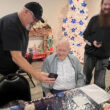Roberta McKern
Right up there with household electricity and the automobile, surely one of the big transformers of the 20th century was the rise of the telephone.
Alexander Graham Bell is generally credited with inventing it, though others were also working in the field. The telephone marked its debut in 1876, the year of the American Centennial. The first public telephone appeared in 1877, but further development of central exchanges by 1879 and of automatic switching equipment ensured its success.
By 1915 Alexander Graham Bell himself made the first transcontinental telephone call from New York to his assistant, Dr. Thomas A. Watson in San Francisco.
Early phone companies were organized by local entrepreneurs. Later they were joined into a national system under the regulated monopoly umbrella of “Ma Bell,” somewhat misleadingly named since different Bell companies operated in various sections of the country.
Maybe they were progeny but Alexander Graham Bell was no “Ma.” Perhaps the name should have been “Pa Bell.”
The East Linn Museum has the good fortune of displaying a number of items associated with those earlier years of “telephony,” as it was called.
One is a stock certificate issued by the Sweet Home, Foster and Cascade telephone company in 1906. Share #29 was priced at $50.00 and purchased by Donald Menear. Capitalized at $5,000, the venture into telephony was organized in 1904 and included an extension to Brownsville.
The museum is also fortunate to possess a collection of 14 earlier telephones – boxy hand-cranked battery-operated wall phones with wooden cases, candlestick phones and three blocky pyramid style ones which came in about any color as long as it was basic Bakelite black.
In the old days, most important to placing calls were the telephone girls, the ladies responsible for connecting incoming calls to desired destinations over a switch board, especially as these exchanges became increasingly centralized.
Apparently, boys were first tried at this job, but they were considered too profane, so for many years it was an occupation reserved for “telephone girls” sometimes just called operators, or, to sell their attractions “the voice with the smile.” (Maybe they were why the telephone company was called Ma Bell.)
With the earliest wall phones, along came party lines where those on the same line could be alerted to an incoming call by recognizing their rings, say two shorts and a long or three shorts and so on.
Listening in on someone else’s call was termed “rubbering,” but the accused might make such an excuse as “Oh, I thought it was my ring. Perhaps I misunderstood.” As one person complained, not only was rubbering a drawback, but you had to be alert to recognize your own ring.
One Sweet Home lady made good use of the party line as a regular correspondent for the Oregonian Newspaper in the 1930s.
Ole Feigum was a popular writer, entertaining her readers with stories of life in the small “village” of Sweet Home. Her stories were taken from what she saw and heard around her (including over the party line)–skipping church to go to the spring and drink its water from an old tobacco tin, washing windows while blackbirds flew over, searching for the stolen hen’s nest….
She was one of seven writers to be selected as “America’s best country newspaper correspondents.”
Phones weren’t cheap in those days, either. In 1897 Sears-Roebuck advertised a wall phone for $13.50 in oak or walnut. For the same amount you could get a middle of the line cast iron kitchen stove or a good saddle.
But the telephone caught on. By the 1920’s a popular song crooned “Hello, Central, give me Dr. Jazz” – Central, of course, being the telephone operator.
Obviously, the singer knew the operator would know just where Dr. Jazz might be found – in a local speak-easy, perhaps, since this was during Prohibition, one with a lively combo featuring a banjo.
When telephone girls were real, not only were they expected to be intelligent and diligent and never guilty of rubbering, but they were sometimes seen as sources of knowledge, someone who could tell a truck driver in unfamiliar territory how to find an address or give recipes for making biscuits and gravy to young guys out on their own. Their discretion was also assured by the placement of supervisors behind their work stations.
By the 1940s even telephone numbers were being celebrated. The swing song, “Pennsylvania 6-5000” the Pennsylvania translating to PA or (72)6-5000, was a far cry from the early numbers which might be something like 5. If a caller said, “Central, give me five,” he could mean the local pharmacy, not a high five!
The phrase, “Hello, Central” goes back in time like the museum’s collection of early telephones.
Even operators with voices that smiled have been replaced by computers and by voice technologies and soon you may be able to call home and remind your house to unlock the front door for you or let the cat in.
To see something of how it once was, it’s nice to be able to come into the East Linn Museum and view the old phones that carried messages over party lines or through centralized operators.
In the old days people might fear that these phones leaked electricity or transmitted lightning, now they are satisfying and stimulating curiosities. Indeed, if once you could ask Central how to make gravy and listen to instructions from a familiar voice, now you can make a similar request to your computer, but the reply will appear on a screen and originate somewhere out in cyberspace.
Roberta McKern is a volunteer at East Linn Museum.




